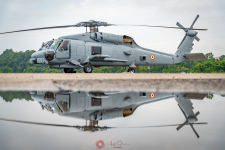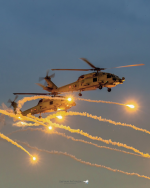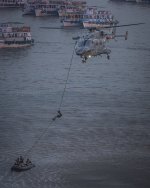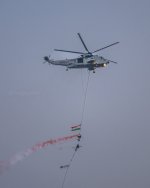You are using an out of date browser. It may not display this or other websites correctly.
You should upgrade or use an alternative browser.
You should upgrade or use an alternative browser.
All 4 don't fold back as of now.Does anyone have any pic of the Dhruv with all 4 blades folded along with the tail boom?
Attachments

Romeos done, Navy to install indigenous software-defined radio in all its aerial assets
SDR, which has been developed by Navy along with BEL, is already fitted in surface ships. Device helps in carrying out signal processing using radio frequency communication systems.
 theprint.in
theprint.in
Deliveries of Romeos also stuck ? Only 5 delivered.
Deliveries of Romeos also stuck ? Only 5 delivered.
9 have been delivered.

Romeos done, Navy to install indigenous software-defined radio in all its aerial assets
SDR, which has been developed by Navy along with BEL, is already fitted in surface ships. Device helps in carrying out signal processing using radio frequency communication systems.
theprint.in
I wish they order one more squadron (10-12 helicopters). DBMRH will take one more decade to reach serial production realistically.
Yes with 12 more we can effectively replace the rest of SeaKings. They do not need to be in asw sensor fitted. The simpler (fitted for but not with) MH60s can effectively take over transport Mk42 variants at a lesser cost.I wish they order one more squadron (10-12 helicopters). DBMRH will take one more decade to reach serial production realistically.
Ideally I would retire the Ka28s too instead of refurbishment and also replace them with more Romeos.
ASW role for SeaKing already retired.Yes with 12 more we can effectively replace the rest of SeaKings.
It's a done deal; they will soon reinduct the upgraded Ka-28.Ideally I would retire the Ka28s too instead of refurbishment and also replace them with more Romeos.
Ka-28s have been refitted with the latest IAI Skimmer ASW mission suites so they will last another 10-15 years. I suspect they will be retired around the same time as the Ka-31s.Ideally I would retire the Ka28s too instead of refurbishment and also replace them with more Romeos.
India – MH-60R Multi-Mission Helicopter Equipment and Follow-on Support
WASHINGTON, December 2, 2024 - The State Department has made a determination approving a possible Foreign Military Sale to the Government of India of MH-60R Multi-Mission Helicopter Equipment and Follow-on Support and related equipment for an estimated cost of $1.17 billion. The Defense Security Cooperation Agency delivered the required certification notifying Congress of this possible sale today.
The Government of India has requested to buy thirty (30) Multifunctional Information Distribution System-Joint Tactical Radio Systems (MIDS-JTRS). The following non-MDE items will also be included: advanced data transfer systems; external fuel tanks; AN/AAS 44C(V) forward looking infrared (FLIR) systems; an operator machine interface assistant; spare containers; facilities study, design, construction and support; support and test equipment; munitions; integration and test support; spare and repair parts; intermediate and depot-level repair capabilities and associated spares; communications equipment; software development, delivery and support, including Joint Mission Planning System (JMPS); Identification Friend or Foe (IFF) equipment; publications and technical documentation; personnel training and training equipment; U.S. Government and contractor engineering, technical, and logistics support services, including Navy Supply Systems Command (NAVSUP) repair capabilities and Performance Based Logistics (PBL); studies and surveys; and other related elements of logistics and program support. The estimated total program cost is $1.17 billion.
This proposed sale will support the foreign policy and national security objectives of the United States by helping to strengthen the United States-India strategic relationship and improving the security of a major defense partner which continues to be an important force for political stability, peace, and economic progress in the Indo-Pacific and South Asia regions.
The proposed sale will improve the Government of India’s capability to deter current and future threats by upgrading anti-submarine warfare capabilities. India will have no difficulty absorbing this equipment and services into its armed forces.
The proposed sale of this equipment and support will not alter the basic military balance in the region.
The principal contractor will be Lockheed Martin Rotary and Mission Systems, located in Owego, NY. The purchaser typically requests offsets. Any offset agreement will be defined in negotiations between the purchaser and the contractor.
Implementation of this sale will require travel of up to twenty U.S. Government or up to twenty-five contractor representatives to the Government of India on a temporary basis for program technical support and management oversight.
India reaches out to US, France for twin-engine naval helicopters
The government has reached out to at least the United States and France to explore government-to-government procurement of twin-engine light naval utility helicopters (NUHs) to augment the maritime capability deficiency.
According to sources privy to the development, the Indian Navy wrote letters at least to the embassies of the United States and France and to some manufacturers, such as Airbus, a European aerospace corporation, for procurement of all-weather twin-engine NUH.
In the capability requirement priority, the Indian Navy stated that the copter, among other things, should be in the 5-tonne category and have folding blades to meet the long-standing requirement of 111 of them for operating from warships to shore and vice versa.
The government is looking for possible emergency procurement of the NUH for the Indian Navy though the letters did not specify the quantity required, sources stated.
The move comes as leading defence PSU Hindustan Aeronautics Ltd has begun the production of 60 deck-based utility helicopters maritime (UHM) after deciding to fund the project in 2023. This was after HAL had given up its NUH project in the past.
Sources said that the design of the 5.8-tonne category UHM, which will also have folded blades to allow the platform to enter a hanger in the hull of a warship, is almost complete, and the project will enter the next phase of gear-box testing.
As per the HAL’s timelines, the UHM is expected to fly in the first quarter of next year, and the defence PSU will be in a position to deliver the rotary-wing aircraft in 2027.
In between, it will take a year for different certifications and rigorous test flying, sources explained.
However, the Indian Navy and Indian Coast Guard are already using 16 naval versions of the Dhruv Mark III helicopters each.
The Indian Navy also operates 24 MH-60R “Seahawk” helicopters of US origin, which have different operational requirements, after their commissioning in March 2024.
These copters are meant for anti-submarine warfare, anti-surface warfare, search and rescue, and other operations.
Airbus from France remains a contender for global procurement of NUH, given that it already has H-135, H-145 and H-160 copters in that twin-engine light copter category.
Besides this, the Indian Coast Guard’s demand for 14 twin-engine heavy-lift copters is also pending for at least the last 7 years.
Though the two countries decided suddenly to end hostilities on Saturday, which had been going on since May 7 after India carried out aerial strikes, dismantling 9 terror infrastructure in Pakistan and Pakistan Occupied Jammu and Kashmir, India had reached out to friendly foreign countries as well as the Indigenous industries for emergency procurement of ammunitions and certain armaments, sources pointed out.
For the domestic players, the MoD has asked them to share their product profiles and their ability to push production timelines if needed. In some cases, orders were also issued, like to drone manufacturers for supply, as such platforms were extensively used for surveillance as well as explosive attacks across the border in Pakistan.
Even defence PSUS like Munition India Ltd were told to expedite their production schedules to meet the requirement of uninterrupted ammunition supply in case the battle with Pakistan lasted long and to replenish the war reserve.
India reaches out to US, France for twin-engine naval helicopters
The government has reached out to at least the United States and France to explore government-to-government procurement of twin-engine light naval utility helicopters (NUHs) to augment the maritime capability deficiency.
According to sources privy to the development, the Indian Navy wrote letters at least to the embassies of the United States and France and to some manufacturers, such as Airbus, a European aerospace corporation, for procurement of all-weather twin-engine NUH.
In the capability requirement priority, the Indian Navy stated that the copter, among other things, should be in the 5-tonne category and have folding blades to meet the long-standing requirement of 111 of them for operating from warships to shore and vice versa.
The government is looking for possible emergency procurement of the NUH for the Indian Navy though the letters did not specify the quantity required, sources stated.
The move comes as leading defence PSU Hindustan Aeronautics Ltd has begun the production of 60 deck-based utility helicopters maritime (UHM) after deciding to fund the project in 2023. This was after HAL had given up its NUH project in the past.
Sources said that the design of the 5.8-tonne category UHM, which will also have folded blades to allow the platform to enter a hanger in the hull of a warship, is almost complete, and the project will enter the next phase of gear-box testing.
As per the HAL’s timelines, the UHM is expected to fly in the first quarter of next year, and the defence PSU will be in a position to deliver the rotary-wing aircraft in 2027.
In between, it will take a year for different certifications and rigorous test flying, sources explained.
However, the Indian Navy and Indian Coast Guard are already using 16 naval versions of the Dhruv Mark III helicopters each.
The Indian Navy also operates 24 MH-60R “Seahawk” helicopters of US origin, which have different operational requirements, after their commissioning in March 2024.
These copters are meant for anti-submarine warfare, anti-surface warfare, search and rescue, and other operations.
Airbus from France remains a contender for global procurement of NUH, given that it already has H-135, H-145 and H-160 copters in that twin-engine light copter category.
Besides this, the Indian Coast Guard’s demand for 14 twin-engine heavy-lift copters is also pending for at least the last 7 years.
Though the two countries decided suddenly to end hostilities on Saturday, which had been going on since May 7 after India carried out aerial strikes, dismantling 9 terror infrastructure in Pakistan and Pakistan Occupied Jammu and Kashmir, India had reached out to friendly foreign countries as well as the Indigenous industries for emergency procurement of ammunitions and certain armaments, sources pointed out.
For the domestic players, the MoD has asked them to share their product profiles and their ability to push production timelines if needed. In some cases, orders were also issued, like to drone manufacturers for supply, as such platforms were extensively used for surveillance as well as explosive attacks across the border in Pakistan.
Even defence PSUS like Munition India Ltd were told to expedite their production schedules to meet the requirement of uninterrupted ammunition supply in case the battle with Pakistan lasted long and to replenish the war reserve.
Why 2 different platforms for ~5 ton NUH?
And last year HAL stated they intend to rollout the UHM prototype by mid 2025. What happened to that now?
The Navy does not have confidence in HAL's ability to deliver on time, thus they are pursuing other means.Why 2 different platforms for ~5 ton NUH?
And last year HAL stated they intend to rollout the UHM prototype by mid 2025. What happened to that now?
















